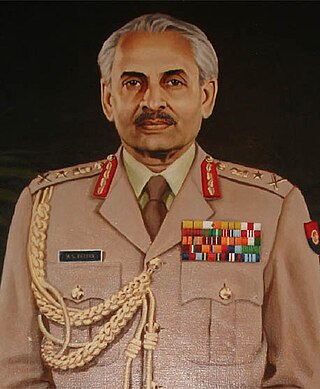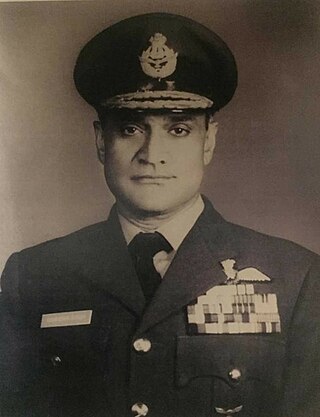
The Maha Vir Chakra (MVC) is the second highest military decoration in India, after the Param Vir Chakra, and is awarded for acts of conspicuous gallantry in the presence of the enemy, whether on land, at sea or in the air. It replaced the British Distinguished Service Order (DSO). The medal may be awarded posthumously.

General Arunkumar Shridhar VaidyaPVSM, MVC & Bar, AVSM, ADC was an Indian Army general. He served as the 13th Chief of the Army Staff from 1983 to 1986. Following his retirement, he was assassinated by Harjinder Singh Jinda and Sukhdev Singh Sukha in August 1986, for his role in Operation Blue Star in 1984.
Air Commodore Ramesh Sakharam Benegal MVC AVSM was an ex-officer of the Indian Air Force and a recipient of Maha Vir Chakra, India's second highest award for gallantry, and the Ati Vishisht Seva Medal.
Rear Admiral Santosh Kumar Gupta, MVC, NM is a former flag officer of the Indian Navy. He was awarded the Maha Vir Chakra, the nation's second-highest gallantry award for his command of INAS 300 during the Indo-Pak War of 1971.
Air Marshal Minoo Merwan Engineer, PVSM, MVC, DFC was a former Air Officer in the Indian Air Force. He is one of the most decorated officers in the Indian Air Force, with the second-highest civil decoration - the Padma Bhushan, two gallantry awards - the Maha Vir Chakra and the Distinguished Flying Cross, and the highest peace-time distinguished service award - the Param Vishisht Seva Medal.
Lieutenant General Khem Karan Singh, MVC was an Indian senior military officer. He was awarded the Padma Bhushan for his role in the 1971 Indo-Pakistani War. He also received the Maha Vir Chakra for his services during the Indo-Pakistani war of 1965.

Squadron Leader Ajjamada Boppayya Devayya MVC is the only Indian Air Force officer to be posthumously awarded the Maha Vir Chakra (MVC). The Maha Vir Chakra is the second highest wartime gallantry award, behind only to the Param Vir Chakra. During the 1965 India-Pakistan War, Devayya was part of a strike mission targeting the Pakistani airbase Sargodha when he was attacked by an enemy aircraft. He shot down the enemy pursuer's plane but in the process his aircraft was damaged and he went missing. Presumably he died in Pakistani territory. Twenty-three years later, in 1988, he was posthumously awarded the MVC award.

Air Chief Marshal Hrushikesh Moolgavkar, PVSM, MVC was a former Air officer in the Indian Air Force. He served as the 9th Chief of the Air Staff of the Indian Air Force from 1 February 1976 till 31 August 1978.
No. 106 Squadron ("Lynxes") is a squadron of the Indian Air Force. It was raised on 1 May 1957 with eight newly inducted PR.57 English Electric Canberras in the strategic photo-reconnaissance role. Initially positioned at Bareilly, later the squadron moved to Agra. When the Canberras were retired in 2007, the squadron was equipped with Hawker Siddeley HS 748 ("Avros"). The motto of the squadron is "Sarva Peshayami".
Wing Commander Padmanabha Gautam, MVC & Bar, VM was an officer in the Indian Air Force. He was awarded the India's second-highest war-time gallantry award, the Maha Vir Chakra twice. Awarded during the Indo-Pakistani War of 1965 and the Indo-Pakistani War of 1971, Gautam is one of only six officers to have been decorated with the Maha Vir Chakra twice.

Lieutenant General Raj Mohan Vohra, PVSM, MVC was a General Officer of the Indian Army. He was awarded the Maha Vir Chakra for his bravery and leadership in the Battle of Basantar during the Indo-Pakistani War of 1971.
Captain Mohan Narayan Rao Samant, MVC was an officer of the Indian Navy, who was awarded with the Maha Vir Chakra, India's second-highest war-time gallantry award. Samant played an important role in the covert operation called Naval Commando Operation X, which was instituted in 1971 during the Bangladesh Liberation War. Samant had also served as the first commanding officer of the submarine INS Karanj after being appointed to that post in 1969. After the 1971 war ended, he became the first temporary Chief of Naval Staff of the newly-created Bangladesh Navy.

Air Vice Marshal Chandan Singh, MVC, AVSM, VrC was an Air Officer in the Indian Air Force. A highly decorated officer, Singh was awarded the Vir Chakra during the Sino-Indian War and the Maha Vir Chakra during the Indo-Pakistani War of 1971.

Vice Admiral Swaraj Parkash, PVSM, MVC, AVSM was a Flag officer in the Indian Navy. He was the Captain of the aircraft carrier INS Vikrant during the Indo-Pakistani War of 1971 for which he was decorated with India's second-highest military decoration, the Maha Vir Chakra. He later served as the second Director General of the Indian Coast Guard from 1980 to 1982.
Air Vice Marshal Madhavendra Banerji, MVC, VM was an ex-officer of the Indian Air Force and a recipient of Maha Vir Chakra, India's second highest gallantry Award and the Vayu Sena Medal.
Air Commodore Harcharan Singh Mangat MVC was an ex-officer of the Indian Air Force, who participated in the Indo-Pakistani War of 1971 for which he was awarded the Maha Vir Chakra, India's second highest military award.
Air Vice Marshal Cecil Vivian Parker, MVC, VM is a former air officer of the Indian Air Force. During the Indo-Pakistani War of 1971, he was awarded the Maha Vir Chakra, India's second highest military decoration. He last served as the Commandant of the Air Force Academy.

Brigadier Rattan Nath Sharma, MVC, was an officer in the Indian Army who served with the Punjab Regiment, and was awarded the Maha Vir Chakra, India's second-highest award for gallantry in the face of the enemy. The award was made for his actions during the Indo-Pakistani War of 1971, when he displayed exemplary courage and outstanding leadership while commanding the 21st Battalion, Punjab Regiment, in a successful assault on a fortified Pakistani position near the Poonch River in the Jammu and Kashmir sector of the Western Front. He retired from the army in 1977 as a brigadier, after which he was the chief managing director of the Indian Farmers Fertiliser Cooperative. He died in a vehicle accident in December 2011.
Air Marshal Ravinder Nath Bhardwaj PVSM MVC VM is a retired officer of the Indian Air Force and a recipient of the Param Vishisht Seva Medal, Maha Vir Chakra and the Vayu Sena Medal.











